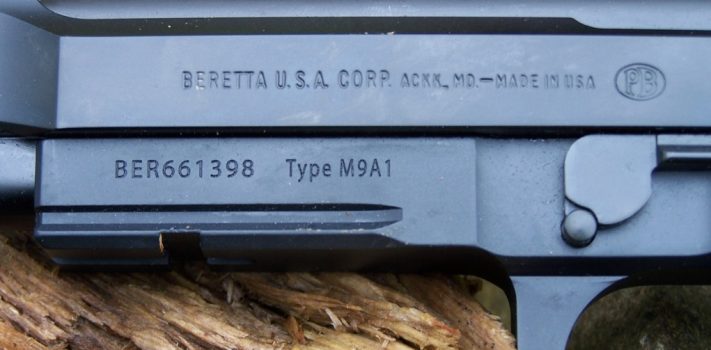I don’t know about other people, but I’ve always been resistant to change or controversy in my life. As I grow older, rapidly approaching my 70th year on this earth, I find I’m more resistant to change than ever. I don’t enjoy getting into a controversy over things. I believe a lot of controversy stems from our opinions on things. Many people simply don’t understand what an opinion is, either. Quite simply, an opinion is just that – an “opinion” and it is based on what we believe. I don’t think an opinion is right or wrong, it’s just one person’s thoughts on something.
I cut my teeth on the grand old 1911, .45 ACP handgun, and it is still my favorite handgun. Now, many readers will remember that I’ve written that in an End Of The World situation, I would select a Glock Model 19X as my one and only handgun, and I still stand by that. Different situations call for different firearms. However, if I could only have one handgun, to meet all my needs in such a situation, it will still be the Glock 19X. It holds a lot of ammunition, is plenty accurate and as reliable as reliable can be. That doesn’t distract from my love affair with the 1911.
Back in the early 1980s, the US military decided it was time to retire the 1911, and they wanted to go with a 9mm handgun. Many of our NATO allies military personnel were carrying 9mm handguns of one type or another. The controversy began immediately, over the 9mm caliber. As we all “know” the .45 ACP, even in FMJ will rip your arm off, even if you are only hit in the pinky finger – that’s how powerful that .45 ACP is – always has been, always will be. Still to this day, these types of rumors persist to the uninitiated. Of course, it is just an uneducated person who believes this, and it is their opinion – and you will never change their thinking.
Many of the big-name gun makers submitted 9mm handguns to testing to the military, hopefully, their designs would meet all the requirements laid out for the testing process, and their gun would be the winner. This testing process actually took several years, and one-by-one the competitors were eliminated due to one short coming or another. It came down to just two makers’ submissions, one was from Beretta and the other from SIG Sauer. In the end, it came down to the price, and to this day, their decision is still controversial over the price. SIG Sauer submitted their bid, as did Beretta. However, those who were there at the closing bids, said that after SIG Sauer submitted their bid, that Beretta then submitted their bid, and it was lower than the SIG bid. This is still a hot topic, to this day. Some people have contended that Beretta somehow “cheated” when that happened. Personally, I prefer the SIG Sauer P226 over the Beretta 92FS. Both are outstanding handguns – it is just my opinion that the SIG is a better gun.
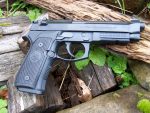 So, for more than a quarter-century, our military personnel have had the Beretta 92FS on their side – as the M9, and there have been several improvements over the years. Today we’re looking at the Beretta M9A1. This model was requested by the United States Marine Corps. There are several minor changes from the civilian Beretta 92FS compared to the M9 series. The sights are slightly different on the 92FS compared to the military versions. Plus, the current 92FS has a “plastic” trigger, whereas, the military versions have an aluminum trigger. The M9A1 also has checkering on the front and back straps that is different from the 92FS. Most of the differences is purely cosmetic.
So, for more than a quarter-century, our military personnel have had the Beretta 92FS on their side – as the M9, and there have been several improvements over the years. Today we’re looking at the Beretta M9A1. This model was requested by the United States Marine Corps. There are several minor changes from the civilian Beretta 92FS compared to the M9 series. The sights are slightly different on the 92FS compared to the military versions. Plus, the current 92FS has a “plastic” trigger, whereas, the military versions have an aluminum trigger. The M9A1 also has checkering on the front and back straps that is different from the 92FS. Most of the differences is purely cosmetic.
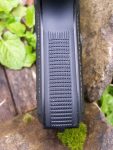 The 92FS (M8) variant came following a few slide failures, where some military personnel were shooting ammo that was basically “proof”-strength submachinegun loads, and a couple of slides broke and came off the guns, injuring the shooters. Beretta was quick to correct this, with the FS model – it has a large “button” that will capture the slide, even if it breaks in half – it can’t slide off the gun. As with any new product, there are always a few problems. And to this day, this is still a hot topic for the uneducated – they only know what a friend told them, or a gun writer mentioned to be a problem, without doing any research themselves to find out that the problem was taken care of many years ago.
The 92FS (M8) variant came following a few slide failures, where some military personnel were shooting ammo that was basically “proof”-strength submachinegun loads, and a couple of slides broke and came off the guns, injuring the shooters. Beretta was quick to correct this, with the FS model – it has a large “button” that will capture the slide, even if it breaks in half – it can’t slide off the gun. As with any new product, there are always a few problems. And to this day, this is still a hot topic for the uneducated – they only know what a friend told them, or a gun writer mentioned to be a problem, without doing any research themselves to find out that the problem was taken care of many years ago.
Contract Magazine Woes
Then, we had problems with magazines that the government was buying – of course, they went to the lowest bidder, and those magazines were junk, pure and simple. They didn’t have a slick coating on them – inside or out – and in the Middle East, there is a lot of sand – and it got inside the magazines, causing them to jam – and they wouldn’t feed the rounds properly. Not a good thing in combat. I had a friend in “The Sandbox” and I sent him some quality magazines for his M9 – with a super-slick coating on the inside and outside of the magazines, and that took care of the problem. Of course, the military is slow to correct problems, so it was a long time before all those magazines from that vendor were destroyed. Again, this was NOT a problem with genuine Beretta factory magazines, or other high-quality magazines such as those made by Mec-Gar.
Unfortunately, our soldiers are generally restricted to using FMJ 9mm ammo on military operations, and this is just outdated thinking. But it is what it is. Granted, the .45 ACP FMJ will be a slightly better stopper than any 9mm FMJ is – but nothing can be done about this – for the time being.
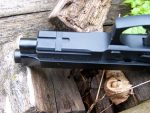 The US Marines were forward-thinking when they requested the M9A1 model – it has a mil-spec Picatinny rail on the dust cover and this allows the user to attach a light or laser to the gun – affording a great advantage to the user in combat. The only problem is, as I see it, there is only one attachment point that you can attach a light or laser on the gun.
The US Marines were forward-thinking when they requested the M9A1 model – it has a mil-spec Picatinny rail on the dust cover and this allows the user to attach a light or laser to the gun – affording a great advantage to the user in combat. The only problem is, as I see it, there is only one attachment point that you can attach a light or laser on the gun.
Concealed Carry?
The full-sized M9 (and M9A1) is a large handgun – Beretta said it is a good gun for concealed carry – well, it is only half true – you have to have the right holster and covering garment to conceal the Beretta M9A1 properly. Of course, most in the military carry their handgun openly. Then we have the DA/SA trigger pull: those with small hands had a difficult time reaching the trigger in the DA (Double Action) mode.
At some point, the government also accepted the SIG Sauer in the form of their P228 compact model 9mm handguns. It was a good choice, for those with smaller hands, as well as plainclothes military operatives, like MPs. I believe it was the FedGov way of saying: “Oops, sorry we picked the Beretta over you…” sort of thing.
Immediately after the military adopted the Beretta M9, many, many major law enforcement agencies around the country – and around the world – picked the Beretta as their service handgun – not a bad choice at all. However, they didn’t do any testing, they just figured the military knew best. I never worked for a police department that mandated that we had to use a particular model handgun or caliber – thankfully.
Collector Variants
In due time, Beretta came out with a limited number of M9 handguns in various versions, for the collectors. I had one that was OD Green and stamped as the US Army version. I’m not a gun collector…I didn’t want to even test-fire my prize. In short order, I sold it to someone who wanted it in a collection and would never fire it. I’ve also owned a number of 92FS Berettas over the years – all great shooters, and more than accurate. They ran very smoothly, too – and never had a malfunction – so long as I used quality magazines in them. They are fantastic handguns, to be sure.
Back To SIG
In the end, the military said that many of the M9s and M9A1 had come to the end of their useful lives, and couldn’t be repaired or rebuilt any longer, and went in search of a replacement. The testing procedures weren’t nearly as tough as it was for the Beretta, and not very many gun makers entered the competition this time around. It came down to the Glock 17 and the SIG Sauer P320. The military wanted a handgun with a manual safety – not a problem for SIG, but it took a while before Glock installed a thumb safety – in the end, SIG won out – and I don’t think the military could have gone wrong with either handgun as the official sidearm of our military. It was adopted as the M17. Of course, as just like I mentioned early on, there were problems with the SIG, but they have been corrected. I could easily live with either the SIG or the Glock – and I own both makes.
My Tests
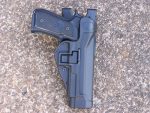 Over the course of a year, I have fired well over 1,500-rounds of 9mm ammo through this gun. Everything that Black Hills Ammunition and Buffalo Bore Ammunition produces in 9mm Parabellum, and I had zero malfunctions. Nothing close to a malfunction. No groups were larger than 3.25-inches. There were a few flyers, but that was my bad. So long as I did my part, and kept my sights on the target, all groups were more than acceptable. Needless to say, all of this shooting was done before the current ammo drought.
Over the course of a year, I have fired well over 1,500-rounds of 9mm ammo through this gun. Everything that Black Hills Ammunition and Buffalo Bore Ammunition produces in 9mm Parabellum, and I had zero malfunctions. Nothing close to a malfunction. No groups were larger than 3.25-inches. There were a few flyers, but that was my bad. So long as I did my part, and kept my sights on the target, all groups were more than acceptable. Needless to say, all of this shooting was done before the current ammo drought.
I know what many of you are thinking, that with the military dumping all those Berettas – they will come on the market when the FedGov releases them. Don’t hold your breath. I don’t see if happening – possibly ever! However, you can still find plenty of Beretta 92FS and civilian versions of the M9/M9A1 on the market at really good prices – for new or used ones. So, don’t hesitate to check one out – that is, if you can find one these days, in the worse gun and ammo drought in history. You get a lot of gun with the Beretta and you won’t be disappointed.

